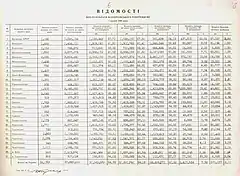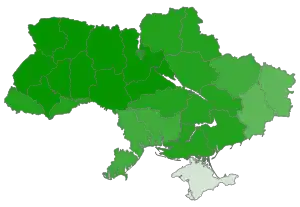1991 Ukrainian independence referendum
A referendum on the Act of Declaration of Independence was held in Ukraine on 1 December 1991.[1] An overwhelming majority of 92.3% of voters approved the declaration of independence made by the Verkhovna Rada on 24 August 1991. Voters were asked "Do you support the Act of Declaration of Independence of Ukraine?"[2] The text of the Declaration was included as a preamble to the question. The referendum was called by the Parliament of Ukraine to confirm the Act of Independence, which was adopted by the Parliament on 24 August 1991.[3] Citizens of Ukraine expressed overwhelming support for independence. In the referendum, 31,891,742 registered voters (or 84.18% of the electorate) took part, and among them 28,804,071 (or 92.3%) voted "Yes".[2]
| ||||||||||||||||||||||
Do you support the Act of Declaration of Independence of Ukraine? | ||||||||||||||||||||||
 The result of the referendum in a bulletin. | ||||||||||||||||||||||
| Results | ||||||||||||||||||||||
|---|---|---|---|---|---|---|---|---|---|---|---|---|---|---|---|---|---|---|---|---|---|---|
| ||||||||||||||||||||||
 | ||||||||||||||||||||||
On the same day, a presidential election took place. In the month up to the presidential election, all six candidates campaigned across Ukraine in favour of independence from the Soviet Union, and a "Yes" vote in the referendum. Leonid Kravchuk, the parliament chairman and de facto head of state, was elected to serve as the first President of Ukraine.[4]
From 2 December 1991 onwards, Ukraine was globally recognized by other countries as an independent state.[5][6][7] Also on 2 December, the President of the Russian SFSR Boris Yeltsin recognized Ukraine as independent.[8][9][10][11] In a telegram of congratulations Soviet President Mikhail Gorbachev sent to Kravchuk soon after the referendum, Gorbachev included his hopes for close Ukrainian cooperation and understanding in "the formation of a union of sovereign states".[12]
Ukraine was the second-most powerful republic in the Soviet Union both economically and politically (behind Russia), and its secession ended any realistic chance of Gorbachev keeping the USSR together. By December 1991 all former Soviet Republics except the RSFSR[13] and the Kazakh SSR[13] had formally seceded from the Union.[14] A week after his election, Kravchuk joined with Yeltsin and Belarusian leader Stanislav Shushkevich in signing the Belavezha Accords, which declared that the Soviet Union had ceased to exist.[15] The USSR officially dissolved on 26 December.[16]
Results

Ukrainian media had converted en masse to the independence ideal.
Polls showed 63% support for the "Yes" campaign in September 1991; that grew to 77% in the first week of October 1991 and 88% by mid-November 1991.[17]
55% of the ethnic Russians in Ukraine voted for independence.[18]
| Choice | Votes | % | |
|---|---|---|---|
| For | 28,804,071 | 92.26 | |
| Against | 2,417,554 | 7.74 | |
| Total | 31,221,625 | 100.00 | |
| Valid votes | 31,221,625 | 97.90 | |
| Invalid/blank votes | 670,117 | 2.10 | |
| Total votes | 31,891,742 | 100.00 | |
| Registered voters/turnout | 37,885,555 | 84.18 | |
| Source: Nohlen & Stöver | |||
By region
The Act of Independence was supported by a majority of participating voters in each of the 27 administrative regions of Ukraine: 24 oblasts, 1 autonomous republic, and 2 special municipalities (Kyiv City and Sevastopol City).[4] Voter turnout was lowest in Eastern and Southern Ukraine.[17] The six regions with the lowest percentage of "yes" votes were Kharkiv, Luhansk, Donetsk, and Odesa Oblasts, Crimea, and Sevastopol; all of those regions still had a majority of registered voters marking their ballots "yes", except for Crimea and Sevastopol.

| Subdivision | Percentage voting for independence | |
|---|---|---|
| Of votes cast[4] | Of electorate[19] | |
| Crimean ASSR | 54.19 | 37[20] |
| Cherkasy Oblast | 96.03 | 87 |
| Chernihiv Oblast | 93.74 | 85 |
| Chernivtsi Oblast | 92.78 | 81 |
| Dnipropetrovsk Oblast | 90.36 | 74 |
| Donetsk Oblast | 83.90 | 64 |
| Ivano-Frankivsk Oblast | 98.42 | 94 |
| Kharkiv Oblast | 86.33 | 65 |
| Kherson Oblast | 90.13 | 75 |
| Khmelnytskyi Oblast | 96.30 | 90 |
| Kyiv Oblast | 95.52 | 84 |
| Kirovohrad Oblast | 93.88 | 83 |
| Luhansk Oblast | 83.86 | 68 |
| Lviv Oblast | 97.46 | 93 |
| Mykolayiv Oblast | 89.45 | 75 |
| Odesa Oblast | 85.38 | 64 |
| Poltava Oblast | 94.93 | 87 |
| Rivne Oblast | 95.96 | 89 |
| Sumy Oblast | 92.61 | 82 |
| Ternopil Oblast | 98.67 | 96 |
| Vinnytsia Oblast | 95.43 | 87 |
| Volyn Oblast | 96.32 | 90 |
| Zakarpattia Oblast | 92.59 | 77 |
| Zaporizhzhia Oblast | 90.66 | 73 |
| Zhytomyr Oblast | 95.06 | 86 |
| Kyiv City | 92.87 | 75 |
| Sevastopol City | 57.07 | 36[20] |
| National Total | 90.32 | 76[21] |
See also
 |
|---|
|
|
References
- Dieter Nohlen & Philip Stöver (2010) Elections in Europe: A data handbook, page 1976 ISBN 9783832956097
- Nohlen & Stöver, p1985
- Historic vote for independence Archived 2014-03-23 at the Wayback Machine, The Ukrainian Weekly (1 September 1991)
- Independence – over 90% vote yes in referendum; Kravchuk elected president of Ukraine Archived 2017-10-19 at the Wayback Machine, The Ukrainian Weekly (8 December 1991)
- Ukraine and Russia: The Post-Soviet Transition by Roman Solchanyk, Rowman & Littlefield Publishers, 2000, ISBN 0742510182 (page 100)
- Canadian Yearbook of International Law, Vol 30, 1992, University of British Columbia Press, 1993, ISBN 9780774804387 (page 371)
- Russia, Ukraine, and the Breakup of the Soviet Union by Roman Szporluk, Hoover Institution Press, 2000, ISBN 0817995420 (page 355
- Russia's Revolution from Above, 1985–2000: Reform, Transition, and Revolution in the Fall of the Soviet Communist Regime by Gordon M. Hahn, Transaction Publishers, 2001, ISBN 0765800497 (page 482)
- A Guide to the United States' History of Recognition, Diplomatic, and Consular Relations, by Country, since 1776: Ukraine, Office of the Historian
- The Limited Partnership: Building a Russian-US Security Community by James E. Goodby and Benoit Morel, Oxford University Press, 1993, ISBN 0198291612 (page 48)
- Ukrainian Independence, Worldwide News Ukraine
- NEWSBRIEFS FROM UKRAINE Archived 2020-11-16 at the Wayback Machine, The Ukrainian Weekly (8 December 1991)
- Russia's New Politics: The Management of a Postcommunist Society by Stephen K. White, Cambridge University Press, 1999, ISBN 0521587379 (page 240)
- Citizens in the Making in Post-Soviet States by Olena Nikolayenko, Routledge, 2001, ISBN 0415596041 (page 101)
- Historical Dictionary of the Russian Federation by Robert A. Saunders & Vlad Strukov, Scarecrow Press, 2010, ISBN 0810854759 (page 75)
- Turning Points – Actual and Alternate Histories: The Reagan Era from the Iran Crisis to Kosovo by Rodney P. Carlisle and J. Geoffrey Golson, ABC-CLIO, 2007, ISBN 1851098852 (page 111)
- Ukrainian Nationalism in the 1990s: A Minority Faith by Andrew Wilson, Cambridge University Press, 1996, ISBN 0521574579 (page 128)
- The Return: Russia's Journey from Gorbachev to Medvedev by Daniel Treisman, Free Press, 2012, ISBN 1416560726 (page 178)
- Ukrainian Nationalism in the 1990s: A Minority Faith by Andrew Wilson, Cambridge University Press, 1996, ISBN 0521574579 (page 129)
- Russians in the Former Soviet Republics by Pål Kolstø, Indiana University Press, 1995, ISBN 978-0-253-32917-2 (page 191)
Ukraine and Russia:Representations of the Past by Serhii Plokhy, University of Toronto Press, 2008, ISBN 978-0-8020-9327-1 (page 184) - Post-Communist Ukraine by Bohdan Harasymiw, Canadian Institute of Ukrainian Studies, 2002, ISBN 1895571448
External links
- "Law of Ukraine N 1660-XII on organization of referendum" (in Ukrainian). 11 October 1991.
- "Law of Ukraine N 1661-XII on text for referendum" (in Ukrainian). 11 October 1991.
- "The funeral of the empire", Leonid Kravchuk, Zerkalo Nedeli (Mirror Weekly), 23 August – 1 September 2001. Available online in Russian and in Ukrainian.
- "Confide in people," Dr. Stanislav Kulchytsky, Zerkalo Nedeli (Mirror Weekly), 1–7 December 2001. Available online in Russian and in Ukrainian.
- Vitaliy Riaboshapka. "Referendum in Ukraine: how it is dangerous and why it is even needed (Референдум в Украине: чем опасен и зачем вообще нужен)". Segodnya. 1 December 2019